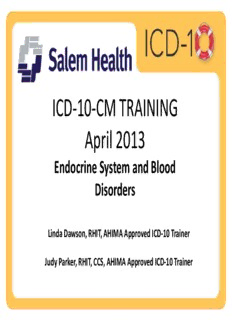
ICD-10-CM TRAINING April 2013 PDF
Preview ICD-10-CM TRAINING April 2013
ICD-10-CM TRAINING April 2013 Endocrine System and Blood Disorders Linda Dawson, RHIT, AHIMA Approved ICD-10 Trainer Judy Parker, RHIT, CCS, AHIMA Approved ICD-10 Trainer CHAPTER 3 Diseases of Blood/Blood-Forming Organs Certain Disorders Involving Immune Mechanism (D50-D89) “Reserved for future guideline expansion” Diseases of Blood/Blood-Forming Organs Certain Disorders Involving Immune Mechanism (D50-D89) 1. Nutritional anemias 2. Hemolytic anemias 3. Aplastic and other bone marrow failure syndromes 4. Coagulation defects and other hemorrhagic conditions 5. Other disorders of blood and blood-forming organs 6. Intraoperative/postprocedural complications of the spleen 7. Certain disorders involving the immune mechanism ““Decreased Red Blood Cell Volume” Abnormally low hemoglobin/hematocrit levelthe (Hgb/Hct) •Etiology: Blood loss Decreased or faulty red blood cell production Destruction of red blood cells •Hemoglobin (Hgb)- Protein in red blood cells that carries oxygen Normal values: Male: 13.8 to 17.2 gm/dL Female: 12.1 to 15.1 gm/dL Note: gm/dL = grams per deciliter •Hematocrit (Hct) - Number and size of red blood cells Normal values: Male: 40.7 - 50.3% Female: 36.1 - 44.3% •Abnormal levels – Hgb/Hct Male: 12/38 Female: 10/32 DOCUMENTATION/CODING OF ANEMIA •Look for specific documentation: Type of anemia (i.e. acute blood loss anemia) •Review: Laboratory/Pathology findings Blood values following a surgical procedure Significant drop of Hgb/Hct Physician's orders for testing, monitoring or for procedures •Query the physician for: Specific diagnosis relating to these findings Underlying cause of the anemia (e.g., due to long-term anticoagulants, gastric ulcer, neoplasm, or internal bleeding) Anemia Due to Blood Loss •Acute blood-loss anemia Sudden, significant loss of blood over a brief period of time Acute blood-loss anemia may occur following surgery, but it is not necessarily a complication of the procedure Arthroplasty patient averages: Hemoglobin drop 3 grams Hematocrit 10% drop Anemia, unspecified (D64.9), is the default when postoperative anemia is documented without specification of blood loss www.aaosnotice.org/2012_Proceedings/adult-knee-BloodLoss.html www.acphospitalist.org/archives/2012/02/coding.htm#sb1 Let’s Code! Postoperative Blood Loss Anemia Following Hip Replacement ALPHABETIC INDEX: TABULAR LIST: D62 - Acute Anemia (essential) (general) Posthemorrhagic (hemoglobin deficiency) Anemia (infantile) (primary) (profound) EXCLUDES 1: •anemia due to chronic postoperative(postprocedural) blood loss (D50.0) due to (acute) blood loss D62 •blood loss anemia NOS (D50.0) •congenital anemia from fetal blood loss (P61.3)
Description: